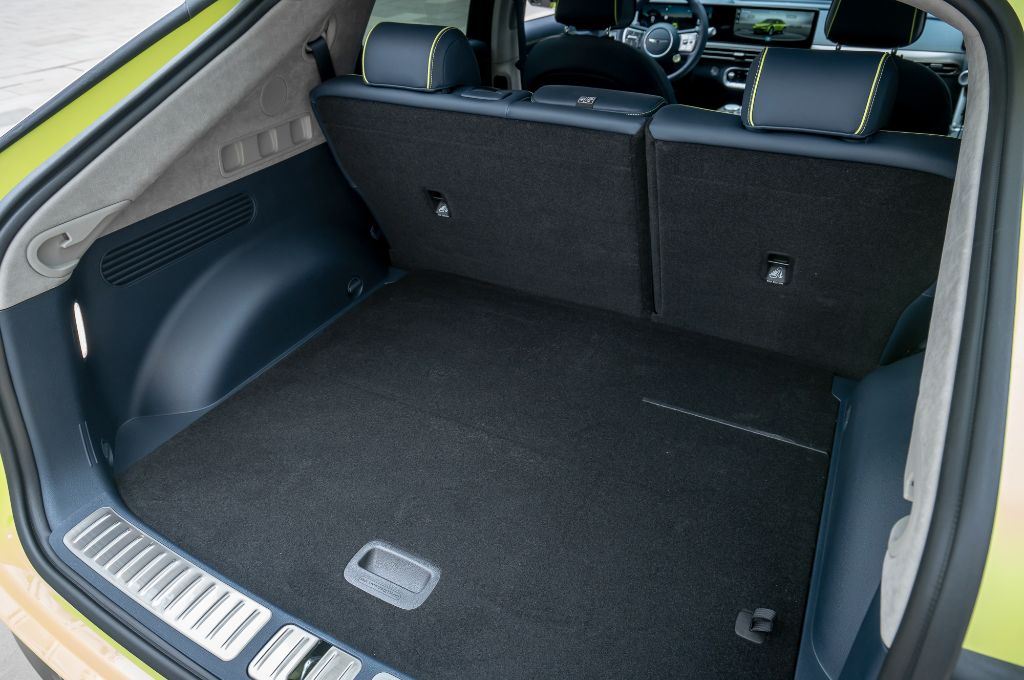Introduction
Three years is a long time in the world of electric cars, and to prove it, we have the facelifted GV60. We’ll get onto the car itself in due course, but its worth noting that a number of things have changed with the company since the arrival of the original. Having started as a company in its own right in the UK, its operations were merged with Hyundai UK in 2023, which is why you’ll now find Genesis cars in your local Hyundai dealership. And that promise to make all new models fully electric by 2025? Well, that’s now shifted to ‘electrified’ models, opening the door to plug-in hybrids and internal combustion engines. Hmm.
Range, battery and charging
In case you didn’t know (and why should you?), the Genesis GV60 rides on the same platform as the Kia EV6 and Hyundai IONIQ 5. Kia and Hyundai increased battery sizes on both those models from 77kWh to 84kWh last year, but the GV60 has had to wait until now to get a bigger pack. Frustratingly, Genesis (like Kia and Hyundai) only quote gross battery size figures, but those in the know suggest that the usable figure (the amount you can actually use) is around 79-80kWh.
The increase in capacity has brought a useful increase in range, which was starting to look a little disappointing against the competition (and its Kia and Hyundai stablemates). The most efficient is the rear-drive, single motor Pure version that now returns 348 miles on the WLTP combined cycle. The dual motor Sport and Performance versions now have 300 mile plus figures, chiming in at 318 and 311 miles respectively. I drove a single-motor Pure version for a couple of hours on a mixed route and averaged 3.4 miles per kWh. Which would mean a real-world range of just under 280 miles. Had we thrown in some motorway driving, I suspect that figure would dip down towards the 260 mark. Not terrible, but not exactly sector-leading efficiency.
The GV60’s trump card is, as before, it’s rapid charging capability. Thanks to its 800 volt electrical system, it has a theoretical maximum charging speed of 240kW. And to help you achieve anywhere near that, Genesis has a battery conditioning function that can heat and cool the battery so that it reaches the perfect temperature when you plug in. Even better news is that the heating/cooling function can now be triggered manually. This means that drivers no longer have to suffer the overly fussy in-built navigation system to take advantage of it, and can continue using Apple CarPlay or Android Auto. Rejoice!
I ought to point out at this point that the ability to condition the battery before a charge isn’t just a gimmick. On a car like the GV60, it can make a huge difference to charging speeds - especially in colder conditions. My old IONIQ 5 would often struggle to hit 60kW when plugged in during winter. Once Hyundai added battery conditioning via a software update, I would regularly see 220kW on ultra-rapid chargers.
Like other cars based on the e-GMP platform, the GV60 has vehicle to load (V2L) functionality. However, it’s not fitted as standard to any models in the range, so if you want to power something from your car, you’ll need to fork out £580 for the optional Vehicle to Load option pack.
Practicality and boot space
In terms of space, the GV60 provides passengers with decent levels of leg and headroom.The wide centre console is more intrusive than it is in a Hyundai IONIQ 5, but that doesn’t detract from the overall feeling of spaciousness. Rear seat passengers benefit from the flat floor and while it can’t match the boxier IONIQ 5 for headroom, the GV60 offers first class levels of comfort all round.

Like its siblings, the GV60 doesn’t quite hit the mark when it comes to boot space. While luggage capacity figures of 680 and 1,460 litres are okay, the boot floor is high and the load area is relatively shallow. If you’re looking for a big hatchback and want to carry bulky stuff such as a dog crate, the GV60 may not be the perfect match. You do get a frunk, though, with a capacity of 53-litres, which is fine for storing cables.
Design, interior and technology
When car makers give their products a mid-life nip and tuck, they usually resort to adding some wackier elements or grafting on a front end from another, newer model (the Škoda Enyaq being the perfect example). Never ones to follow the crowd, Genesis has gone the other way with the facelifted GV60.
The weird open-mouthed grille with the sort-of goatee beard below? Gone. The contrast colour wheel arches and side trims? Gone. The bonkers lime green paintwork? Also gone.
Presumably in an effort to broaden its appeal, Genesis has opted to make the new GV60 a little more… well, normal. And actually, that’s no bad thing. To my eyes, the original always looked a little too fussy - a touch too designed. The facelifted car is cleaner, less decorated and, in my irrelevant opinion, all the better for it. The front end is neater and more cohesive than before while the removal of the wheel arch trims gives it a smoother profile. Less is more, as this exercise proves.
Sadly though, you still don’t get rear wiper. Although the IONIQ 5 gained one as part of its facelift, the GV60 doesn’t, so be prepared to have a bottle of Mr Muscle and a microfibre cloth under the false floor in the boot.
As before GV60 is a deceptive car. Thanks to its huge wheels and oversized lights, it looks almost compact in photos. In reality, it’s closer in size to family SUVs such as the ŠKODA Enyaq or Volkswagen ID.4. And while it’s fractionally shorter than both the EV6 and IONIQ 5, it’s a big car.
Inside, the whole less is more approach is less in evidence. While there are improvements and new features, such as the infotainment screen that is now one long 27-inch display as opposed to two separate ones with a dead area in middle, it’s largely unchanged.
As before, the GV60 certainly feels more ‘premium’ than its Kia and Hyundai stablemates. The materials generally feel a notch up on what you would find on the EV6 and IONIQ 5, while the seats have a more upholstered look and feel.
That said, the GV60 still has some disappointing elements. While it’s great to see buttons for things like the seat heaters, the Korean obsession with shiny silver plastic does the cabin no favours. Not only do they look and feel cheap, but because they’re silver, seeing what the switch is for can be impossible in certain lights. In direct sunlight, you simply can’t read the writing or see the tiny LED light that indicates whether the switch is on or off. Mercedes flirted with silver switchgear for a brief period in the 2000s before ditching it. Genesis should consider taking a similar approach.
The gear selector is located on the raised centre console and sits just behind what looks like a second gear selector. The smaller wheel controls the infotainment system and works in largely the same way as BMW’s iDrive system.
The gear selector itself is still quite the conversation piece and is either a work of art of a pointless gimmick, depending on your outlook / cynicism. In standby mode (ie not turned on), the selector takes the form of a crystal sphere that glows to match the ambient light settings. Press the start button the dashboard and the sphere rotates in a kind of James Bond / Indiana Jones fashion to reveal the selector wheel. It’s a fun bit of theatre, and while it doesn’t add a thing to the driving experience, it’s always good to see a few gimmicks that make it from concept to production.
Genesis has cleverly re-skinned the GV’s infotainment system to give it a more premium look. While it still has the functionality of the Hyundai and Kia systems (including the clever blind-spot camera on the main display), the vertical tiles of the main screen are easy to navigate and decently quick to react. The main binnacle display also comes with additional animations including a brilliant navigation indicator that overlays directions on a real-time camera feed from the front of the car. And just in case you need even more information, there’s a clear and easy-to-use head-up display on all models. For the facelift, Genesis has added more features, including the integration of Netflix and other streaming services, which is a welcome addition.
Motors, performance and handling
Customers have three power outputs to choose from, along with the option of all-wheel drive. The entry-level Pure model has a single motor that drives the rear wheels and develops 228hp. Sport models introduce a second motor on the front axle along with a power increase to 318hp, while the range-topping Sport Plus delivers up to 490hp thanks to a 245hp motor on each axle.
That’s enough power to get the GV60 from 0-62mph in as little as 4.0 seconds. Opt for the rear-drive Pure model and you’ll be able to do the same sprint in 7.8 seconds. To keep drivers entertained, Genesis also offers Performance owners a temporary power increase via boost button on the steering wheel. Hit the button and the motor output is lifted by 27hp for 10 seconds.
Bizarrely, Genesis still also offers drivers the opportunity to select a special ‘Drift mode’. This setting alters the torque split and brakes to allow drivers to override the stability control and slide two tonnes of GV60 if whatever direction they please. Perfect for whenever you find yourself on a deserted airfield.
Genesis has also added a virtual gearshift function (borrowed from the Hyundai IONIQ 5N and Kia EV6 GT). I tried it on the track (Genesis opted to launch the car at Thruxton race circuit) and found it to be a fun but ultimately pretty pointless bit of tech. It’s an undoubtedly clever clearly designed to win over the ‘I need to feel what the car is doing’ crowd, but it leaves me rather cold. But if you do like that sort of thing, I’m happy to report that it does exactly what it sets out to do.
On the road, the GV60 delivers a great drive. On the 19-inch wheels of my Pure test car, the ride proved compliant with all the biggest bumps are steamrollered long before they make their presence felt in the cabin. The steering, which has been tweaked to make it more responsive, feels quicker than before with less arm twirling required to get it around tighter corners. Genesis has also improved the front and rear shock absorber performance, increasing the the damping force to enhance stability and ride comfort. Additionally, hydro bushings, which were previously on the front suspension, have been added to the rear to minimise road vibrations.
And yet while the motors deliver savage acceleration when you need them to, and the electronic limited slip differential does a good job of channelling power to the wheels, the GV60 doesn’t feel a particularly sporty car. It can certainly behave like a performance car if 0-62mph times are your defining factor, but you’ll get much more reward just enjoying the huge levels of torque on a meandering A road. It’s a car that feels at its best when you’re not trying to squeeze out every last drop of power.
Running costs and pricing
The updated range kicks off with the GV60 Pure, priced from £54,115. It comes with a 27-inch OLED curved display, heated front seats and steering wheel, and 19-inch alloys. Genesis has packed in all the expected tech, including Smart Regenerative Braking 3.0, I-Pedal one-pedal driving, and Battery Conditioning, fingerprint recognition, wireless phone charger, and a power-assisted tailgate.
Move up to the Sport (from £58,515) and you’ll get larger 20-inch alloys along with the more powerful, all-wheel drive drivetrain. The flagship GV60 Performance, priced from £67,715, adds Boost Mode, Drift Mode, 21-inch alloys, Virtual Gearshift, and an electronic limited-slip differential (e-LSD). Inside, you’ll find Nappa leather upholstery, metal pedals, and a trio of option packs, Comfort, Innovation and Nappa Leather, all included as standard. Safety tech includes Highway Driving Assist and Parking Collision Avoidance Assist.
If the prices look familiar, that’s because they haven’t gone up. Despite the increase in battery size, Genesis has massaged the standard specifications to bring the new car to market without a price increase. Drill down into the list of kit and you’ll notice that items like multi-way adjustable seats and electronic rake control for steering wheel are now part of option packs rather than standard fit.
Verdict
The updated GV60 is without doubt an improved product. The design is more coherent, the range is better suited to higher mileage drivers and the tech improvements are welcome. It’s a shame that it has taken so long for the GV60 to get kit and features that have been available on the Kia EV6 and Hyundai IONIQ 5 for more than a year, but better late than never. The GV60 remains a left-field choice, especially given its ambitious price tag, but it has a certain charm that will appeal to buyers who don’t want to follow the crowd.














